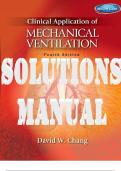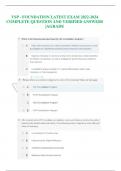Exam (elaborations)
Clinical Application of Mechanical Ventilation 4th Edition by Chang David | SOLUTIONS MANUAL for - All Chapters 1-18 _Answers to Workbook Questions
SOLUTIONS MANUAL for Clinical Application of Mechanical Ventilation 4th Edition by Chang David. ISBN 7348 (All Chapters 1-18). TABLE OF CONTENTS Chapter 1: Principles of Mechanical Ventilatio n Chapter 2: Effects of Positive Pressure Ventilation Chapter 3: Classification of Mechanical Ventilators C...
[Show more]




